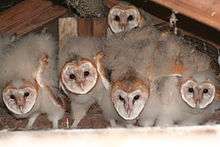Barn owl
| Barn owl | |
|---|---|
.jpg) | |
| Barn owl at the British Wildlife Centre, England Barn Owl screams recorded in Cardiganshire, Wales | |
| Scientific classification | |
| Kingdom: | Animalia |
| Phylum: | Chordata |
| Class: | Aves |
| Order: | Strigiformes |
| Family: | Tytonidae |
| Subfamily: | Tytoninae |
| Genus: | Tyto |
| Species: | T. alba |
| Binomial name | |
| Tyto alba (Scopoli, 1769) | |
| Subspecies | |
|
many, see text | |
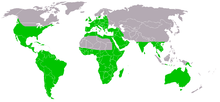 | |
| Global range in green | |
| Synonyms | |
|
Strix alba Scopoli, 1769 | |
The barn owl (Tyto alba) is the most widely distributed species of owl and one of the most widespread of all birds. It is also referred to as the common barn owl, to distinguish it from other species in its family, Tytonidae, which forms one of the two main lineages of living owls, the other being the typical owls (Strigidae). The barn owl is found almost everywhere in the world except polar and desert regions, Asia north of the Himalayas, most of Indonesia, and some Pacific islands.[2]
Phylogenetic evidence shows that there are at least three major lineages of barn owl, one in Eurasia and Africa, one in Australasia and one in the Americas, and some highly divergent taxa on islands. Some authorities further split the group, recognising up to five species, and further research needs to be done to clarify the position. There is a considerable variation between the sizes and colour of the approximately 28 subspecies but most are between 33 and 39 cm (13 and 15 in) in length with wingspans ranging from 80 to 95 cm (31 to 37 in). The plumage on head and back is a mottled shade of grey or brown, the underparts vary from white to brown and are sometimes speckled with dark markings. The face is characteristically heart-shaped and is white in most subspecies. This owl does not hoot, but utters an eerie, drawn-out shriek.
The barn owl is nocturnal over most of its range, but in Britain and some Pacific islands, it also hunts by day. Barn owls specialise in hunting animals on the ground and nearly all of their food consists of small mammals which they locate by sound, their hearing being very acute. They mate for life unless one of the pair gets killed, when a new pair bond may be formed. Breeding takes place at varying times of year according to locality, with a clutch, averaging about four eggs, being laid in a nest in a hollow tree, old building or fissure in a cliff. The female does all the incubation, and she and the young chicks are reliant on the male for food. When large numbers of small prey are readily available, barn owl populations can expand rapidly, and globally the bird is considered to be of least conservation concern. Some subspecies with restricted ranges are more threatened.
Taxonomy and etymology
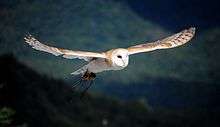

The barn owl was one of several species of bird first described in 1769 by the Tyrolean physician and naturalist Giovanni Antonio Scopoli in his Anni Historico-Naturales. He gave it the scientific name Strix alba.[3][4] As more species of owl were described, the genus name Strix came to be used solely for the wood owls in the typical owl family Strigidae, and the barn owl became Tyto alba in the barn owl family Tytonidae. The name literally means "white owl", from the onomatopoeic Ancient Greek tyto (τυτώ) for an owl – compare English "hooter" – and Latin alba, "white".[2] The bird is known by many common names which refer to its appearance, call, habitat, or its eerie, silent flight: white owl, silver owl, demon owl, ghost owl, death owl, night owl, rat owl, church owl, cave owl, stone owl, monkey-faced owl, hissing owl, hobgoblin or hobby owl, dobby owl, white-breasted owl, golden owl, scritch owl, screech owl, straw owl, barnyard owl, and delicate owl.[2][5] "Golden owl" might also refer to the related golden masked owl (T. aurantia). "Hissing owl" and, particularly in the UK and in India, "screech owl", refers to the piercing calls of these birds.[6] The latter name is also applied to a different group of birds, the screech-owls in the genus Megascops.[2]
The ashy-faced owl (T. glaucops) was for some time included in T. alba, and by some authors its populations from the Lesser Antilles still are. Based on DNA evidence, König, Weick & Becking (2009) recognised the American Barn Owl (T. furcata) and the Curaçao Barn Owl (T. bargei) as separate species.[7] They also proposed that T. a. delicatula should be split off as a separate species, to be known as the eastern barn owl, which would include the subspecies T. d. sumbaensis, T. d. meeki, T. d. crassirostris and T. d. interposita.[8] However, the International Ornithological Committee has doubts about this and states that the split of Tyto delicatula from T. alba "may need to be revisited".[9] Some island subspecies are occasionally treated as distinct species, a move which should await further research into barn owl phylogeography. According to Bruce in the Handbook of Birds of the World, Volume 5: Barn-owls to Hummingbirds, "a review of the whole group [is] long overdue".[2] Molecular analysis of mitochondrial DNA shows a separation of the species into two clades, an Old World alba and a New World furcata, but this study did not include T. a. delicatula which the authors seem to have accepted as a separate species. A high amount of genetic variation was also found between the Indonesian T. a. stertens and other members of the alba clade.[10]
The barn owl has a wider distribution than any other species of owl. Many subspecies have been proposed over the years but several are generally considered to be intergrades between more distinct populations. Twenty to thirty are usually recognised, varying mainly in body proportions, size and colour. Island forms are mostly smaller than mainland ones, and those inhabiting forests have darker plumage and shorter wings than those occurring in open grasslands.[11] Barn owls range in colour from the almost beige-and-white nominate subspecies, erlangeri and niveicauda, to the nearly black-and-brown contempta.[2]
In the Handbook of Birds of the World, Volume 5: Barn-owls to Hummingbirds, the following subspecies are listed:[2]
| Subspecies | Description | Range | Synonyms |
|---|---|---|---|
T. a. alba (Scopoli, 1769)  Light coloured adult | Upperparts grey and light buff. Underparts white, with few if any black spots; males often appear entirely unspotted.[12] | W Europe from the British Isles south to the Maghreb and west along Mediterranean coastal regions to NW Turkey in the north and the Nile in the south, where it reaches upstream to NE Sudan. Also Aïr Mountains in the Sahara of Niger, Balearic Islands and Sicily in the Mediterranean, and the W Canary Islands (El Hierro, La Gomera, La Palma Gran Canaria and Tenerife). Intergrades with guttata from the Balkans through Hungary and along the Rhine and lower Meuse rivers, and with affinis around the Egypt-Sudan border.[2] | Common barn owl – Includes hostilis, kirchhoffi, kleinschmidti, pusillus. African populations might belong to erlangeri. |
T. a. javanica (J. F. Gmelin, 1788)  In Northern Territory, Australia | Large. Similar to alba but darker above, and with conspicuous speckling overall.[2] | Pacific barn owl—Malay Peninsula through the southern Greater Sunda Islands including Kangean Islands, Krakatoa and the Thousand Islands; also Alor Archipelago, Kalao and Tanahjampea in the Selayar Islands, Kalaotoa, and possibly S Borneo.[2] | Southeast Asian birds are sometimes placed here but seem closer to stertens. |
T. a. furcata (Temminck, 1827)  In Cuba | Large. Upperparts pale orange-buff and brownish-grey, underparts whitish with few speckles. Face white.[2] | Cuba, Jamaica, Cayman Islands (rare or extinct on Grand Cayman).[13] | American Barn Owl – Might include niveicauda. |
T. a. tuidara (J. E. Grey, 1829).jpg) In Brazil | Upperparts grey and orange-buff. Underparts whitish to light buff with little speckling. Face white. Resembles pale Old World guttata.[2] | South American lowlands east of the Andes and south of the Amazon River all the way south to Tierra del Fuego; also on the Falkland Islands.[2] | Includes hauchecornei and possibly hellmayri. |
T. a. guttata (C. L. Brehm, 1831) 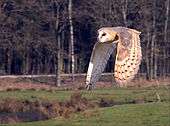 In flight, Sandesneben (Germany) | More grey on upperparts than alba. Underparts buff to rufous with some dark speckles (more than in alba[12]). Face whitish. Females are on average redder below than males.[2] | C Europe north of the Alps from the Rhine to Latvia, Lithuania and Ukraine, and south to Romania, NE Greece and the S Balkans. Intergrades with alba at the western border of its range.[2] | Includes rhenana. |
T. a. delicatula (Gould, 1837) 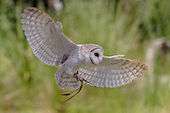 In flight | Similar to alba; slightly darker above, more speckles below. Tail with 4 bark brown bars.[2] | Australia and offshore islets (not on Tasmania), Lesser Sunda Islands (Savu, Timor, Jaco, Wetar, Kisar, Tanimbar, possibly Rote), Melanesia (New Caledonia and Loyalty Islands; Aneityum, Erromango and Tanna in S Vanuatu; Solomon Islands including Bougainville; Long Island, Nissan, Buka and perhaps New Ireland and N New Britain), W Polynesia (Fiji and Rotuma, Niue, Samoan Islands, Tonga, Wallis and Futuna); introduced to Lord Howe Island but became extinct again.[2] | Australian barn owl – Includes bellonae, everetti, kuehni, lifuensis and lulu. Reports of blackish barn-owls on Fiji require investigation. |
T. a. pratincola (Bonaparte, 1838)  Adult in flight | Large. Upperparts grey and orange-buff. Underparts whitish to light buff with much speckling. Face white. Resembles pale Old World guttata, but usually more speckles below.[2] | North America from S Canada south to C Mexico; Bermuda, Bahamas, Hispaniola; introduced to Lord Howe Island (where it became extinct again) and in 1958 to Hawaii (where it persists).[2] | Galápagos barn owl – Includes lucayana and might include bondi, guatemalae, subandeana. |
T. a. punctatissima (G. R. Grey, 1838) 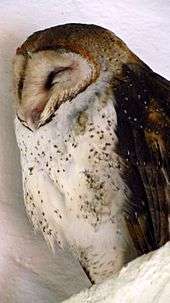 On Santa Cruz Island (Galápagos) | Small. Dark greyish brown above, with white part of spots prominent. Underparts white to golden buff, with distinct pattern of brown vermiculations or fine dense spots.[2] | Galápagos barn owl—Endemic to the Galápagos islands.[2] | Sometimes considered a distinct species. |
| T. a. poensis (Fraser, 1842) | Upperparts golden-brown and grey with very bold pattern. Underparts light buff with extensive speckles. Face white.[2] | Endemic to Bioko, if not the same as affinis.[2] | |
| T. a. thomensis (Hartlaub, 1852) | Smallish. Upperparts dark brownish grey with bold pattern, including lighter brown bands on remiges and rectrices. Underparts golden brown with extensive speckles. Face buff.[2] | Endemic to São Tomé Island. A record from Príncipe is in error.[2] | São tomé barn owl – Sometimes considered a distinct species. |
T. a. affinis (Blyth, 1862)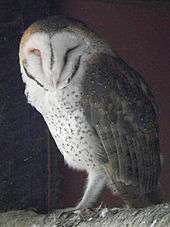 In Tanzania | Similar to poensis, but supposedly lighter on average. Upperparts very grey. Underparts light buff with extensive speckles. Face white.[14] | Sub-Saharan Africa, including the Comoros, Madagascar, Pemba and Unguja islands; introduced to the Seychelles. Intergrades with alba around the Egypt-Sudan border.[2] | Includes hypermetra; doubtfully distinct from poensis.[14] |
| T. a. guatemalae (Ridgway, 1874) | Similar to dark pratincola; less grey above, coarser speckles below.[2] | Guatemala or S Mexico through Central America to Panama or N Colombia; Pearl Islands.[2] | Includes subandeana; doubtfully distinct from pratincola. |
| T. a. bargei (Hartert, 1892) | Similar to alba; smaller and noticeably short-winged.[2] | Curaçao barn owl – Endemic to Curaçao and maybe Bonaire in the West Indies.[2] | |
| T. a. sumbaensis (Hartert, 1897) | Large, particularly the bill. Similar to javanica; tail whitish with black bars.[2] | Madagascare red owl – Endemic to Sumba.[2] | |
| T. a. contempta (Hartert, 1898) | Almost black with some dark grey above, the white part of the spotting showing prominently. Reddish brown below.[2] | NE Andes from W Venezuela through E Colombia (rare in the Cordillera Central and Cordillera Occidental)[15] south to Peru.[2] | Includes stictica. |
| T. a. schmitzi (Hartert, 1900) | Small. Similar to guttata, but breast region light buff.[2] | Endemic to Madeira and Porto Santo islands in the E Atlantic.[2] | |
| T. a. ernesti (Kleinschmidt, 1901) | Similar to alba; breast region always pure unspotted white.[2] | Endemic to Corsica and Sardinia in the Mediterranean.[2] | |
| T. a. gracilirostris (Hartert, 1905) | Small. Similar to schmitzi but breast darker, approaching guttata. Face light buff.[2] | Canary barn owl—Endemic to the E Canary Islands (Chinijo Archipelago, Fuerteventura, Lanzarote; perhaps formerly also on Lobos).[2] | |
| T. a. meeki (Rothschild & Hartert, 1907) | Large. Similar to javanica; tail whitish with grey bars, underparts silvery-white with arrowhead-shaped speckles (larger than in javanica).[2] | E New Guinea and Manam and Karkar islands.[2] | |
| T. a. detorta (Hartert, 1913) | Similar to guttata, but less reddish. Face buff.[2] | Endemic to the Cape Verde Islands.[2] | Cape Verde barn owl – Sometimes considered a distinct species. |
| T. a. erlangeri (W. L. Sclater, 1921) | Similar to ernesti; upperparts lighter and yellower.[2] | Crete and southern Aegean islands to Cyprus; Near and Middle East including Arabian Peninsula coastlands, south to Sinai and east to SW Iran.[2] | Might include African populations assigned to alba. |
T. a. stertens (Hartert, 1929)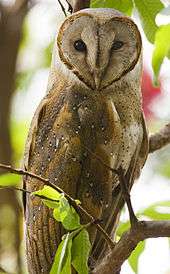 | Similar to alba, but noticeably speckled below.[2] | W Pakistan through India east to Yunnan and Vietnam, south S Thailand; N Sri Lanka.[2] | Southeast Asian birds sometimes included in javanica. |
| T. a. crassirostris (Mayr, 1935) | Similar to delicatula; darker, with stronger bill and feet.[2] | Boang barn owl – Endemic to the Tanga Islands.[2] | |
| T. a. interposita (Mayr, 1935) | Similar to delicatula; darker, with orange hue.[2] | Santa Cruz Islands and Banks Islands south to Efate Island (Vanuatu).[2] | |
| T. a. hellmayri (Griscom & Greenway, 1937) | Similar to tuidara but larger.[2] | NE South American lowlands from E Venezuela south to the Amazon River.[2] | Doubtfully distinct from tuidara. |
| T. a. bondi (Parks & Phillips, 1978) | Similar to pratincola; smaller and paler on average.[2] | Endemic to Roatán and Guanaja in the Bay Islands.[2] | Doubtfully distinct from pratincola. |
| T. a. niveicauda (Parks & Phillips, 1978) | Large. Similar to furcata; paler in general. Resembles Old World alba.[2] | Endemic to Isla de la Juventud.[2] | Doubtfully distinct from furcata. |
Description
The barn owl is a medium-sized, pale-coloured owl with long wings and a short, squarish tail. There is considerable size variation across the subspecies with a typical specimen measuring about 33 to 39 cm (13 to 15 in) in overall length, with a full range of 29 to 44 cm (11 to 17 in) across the species. Barn owls have a typical wingspan of some 80 to 95 cm (31 to 37 in), with a full range of 68 to 105 cm (27 to 41 in).[7][16] Adult body mass is also variable with male owls from the Galapagos (T. a. punctatissima) weighing approximately 260 g (9.2 oz) on average while male Pacific barn owls (T. a. javanica) average 555 g (19.6 oz). The full known weight range for the barn owl species can range from 224 to 710 g (7.9 to 25.0 oz).[17] In general, owls living on small islands are smaller and lighter, perhaps because they have a higher dependence on insect prey and need to be more manoeuvrable.[18] However, the largest bodied race of barn owl, T. a. furcata from Cuba and Jamaica, is also an island race, albeit being found on more sizeable islands with larger prey and few larger owls competing for dietary resources.[16] The shape of the tail is a means of distinguishing the barn owl from typical owls when seen in the air. Other distinguishing features are the undulating flight pattern and the dangling, feathered legs. The pale face with its heart shape and black eyes give the flying bird a distinctive appearance, like a flat mask with oversized, oblique black eye-slits, the ridge of feathers above the beak somewhat resembling a nose.[19]
The bird's head and upper body typically vary between pale brown and some shade of grey (especially on the forehead and back) in most subspecies. Some are purer, richer brown instead, and all have fine black-and-white speckles except on the remiges and rectrices (main wing feathers), which are light brown with darker bands. The heart-shaped face is usually bright white, but in some subspecies it is brown. The underparts, including the tarsometatarsal (lower leg) feathers, vary from white to reddish buff among the subspecies, and are either mostly unpatterned or bear a varying number of tiny blackish-brown speckles. It has been found that at least in the continental European populations, females with more spotting are healthier than plainer birds. This does not hold true for European males by contrast, where the spotting varies according to subspecies. The beak varies from pale horn to dark buff, corresponding to the general plumage hue, and the iris is blackish brown. The talons, like the beak, vary in colour, ranging from pink to dark pinkish-grey and the talons are black.[2][12]
On average within any one population, males tend to have fewer spots on the underside and are paler in colour than females. The latter are also larger with a strong female T. alba of a large subspecies weighing over 550 g (19.4 oz), while males are typically about 10% lighter. Nestlings are covered in white down, but the heart-shaped facial disk becomes visible soon after hatching.[20]
Contrary to popular belief, the barn owl does not hoot (such calls are made by typical owls, like the tawny owl or other members of the genus Strix). It instead produces the characteristic shree scream, ear-shattering at close range, an eerie, long-drawn-out shriek. Males in courtship give a shrill twitter. Both young and old can hiss like a snake to scare away intruders. Other sounds produced include a purring chirrup denoting pleasure, and a "kee-yak", which resembles one of the vocalisations of the tawny owl. When captured or cornered, the barn owl throws itself on its back and flails with sharp-taloned feet, making for an effective defence. In such situations it may emit rasping sounds or clicking snaps, produced probably by the beak but possibly by the tongue.[19][21]
Distribution
The barn owl is the most widespread landbird species in the world, occurring in every continent except Antarctica.[22] Its range includes all of Europe (except Fennoscandia and Malta), most of Africa apart from the Sahara, the Indian subcontinent, Southeast Asia, Australia, many Pacific Islands, and North, Central and South America.[22] In general it is considered to be sedentary, and indeed many individuals, having taken up residence in a particular location, remain there even when better foraging areas nearby become vacant. In the British Isles, the young seem largely to disperse along river corridors and the distance travelled from their natal site averages about 9 km (5.6 mi).[23]
In continental Europe the distance travelled is greater, commonly somewhere between 50 and 100 kilometres (31 and 62 mi) but exceptionally 1,500 km (932 mi), with ringed birds from the Netherlands ending up in Spain and in Ukraine. In the United States, dispersal is typically over distances of 80 and 320 km (50 and 199 mi), with the most travelled individuals ending up some 1,760 km (1,094 mi) from the point of origin. Movements in the African continent include 1,000 km (621 mi) from Senegambia to Sierra Leone and up to 579 km (360 mi) within South Africa. In Australia there is some migration as the birds move towards the northern coast in the dry season and southward in the wet, and also nomadic movements in association with rodent plagues. Occasionally, some of these birds turn up on Norfolk Island, Lord Howe Island or New Zealand, showing that crossing the ocean is not beyond their capabilities.[2] In 2008, barn owls were recorded for the first time breeding in New Zealand.[24] The barn owl has been successfully introduced into the Hawaiian island of Kauai in an attempt to control rodents, however it has been found to also feed on native birds.[25]
Behaviour and ecology

Like most owls, the barn owl is nocturnal, relying on its acute sense of hearing when hunting in complete darkness. It often becomes active shortly before dusk and can sometimes be seen during the day when relocating from one roosting site to another. In Britain, on various Pacific Islands and perhaps elsewhere, it sometimes hunts by day. This practice may depend on whether the owl is mobbed by other birds if it emerges in daylight.[2] However, in Britain, some birds continue to hunt by day even when mobbed by such birds as magpies, rooks and black-headed gulls, such diurnal activity possibly occurring when the previous night has been wet making hunting difficult. By contrast, in southern Europe and the tropics, the birds seem to be almost exclusively nocturnal, with the few birds that hunt by day being severely mobbed.[26]
Barn owls are not particularly territorial but have a home range inside which they forage. For males in Scotland this has a radius of about 1 km (0.6 mi) from the nest site and an average size of about 300 hectares. Female home ranges largely coincide with that of their mates. Outside the breeding season, males and females usually roost separately, each one having about three favoured sites in which to conceal themselves by day, and which are also visited for short periods during the night. Roosting sites include holes in trees, fissures in cliffs, disused buildings, chimneys and haysheds and are often small in comparison to nesting sites. As the breeding season approaches, the birds move back to the vicinity of the chosen nest to roost.[27]
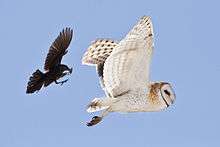
The barn owl is a bird of open country such as farmland or grassland with some interspersed woodland, usually at altitudes below 2,000 metres (6,600 ft) but occasionally as high as 3,000 metres (9,800 ft) in the tropics. This owl prefers to hunt along the edges of woods or in rough grass strips adjoining pasture. It has an effortless wavering flight as it quarters the ground, alert to the sounds made by potential prey. Like most owls, the barn owl flies silently; tiny serrations on the leading edges of its flight feathers and a hairlike fringe to the trailing edges help to break up the flow of air over the wings, thereby reducing turbulence and the noise that accompanies it. Hairlike extensions to the barbules of its feathers, which give the plumage a soft feel, also minimise noise produced during wingbeats.[28] The behaviour and ecological preferences may differ slightly even among neighbouring subspecies, as shown in the case of the European T. a. guttata and T. a. alba that probably evolved, respectively, in allopatric glacial refugia in southeastern Europe, and in Iberia or southern France.[12][29]
Diet and feeding
.jpg)
The diet of the barn owl has been much studied; the items consumed can be ascertained from identifying the prey fragments in the pellets of indigestible matter that the bird regurgitates. Studies of diet have been made in most parts of the bird's range, and in moist temperate areas over 90% of the prey tends to be small mammals, whereas in hot, dry, unproductive areas, the proportion is lower, and a great variety of other creatures are eaten depending on local abundance. Most prey is terrestrial but bats and birds are also taken, as well as lizards, amphibians and insects. Even when they are plentiful and other prey scarce, earthworms do not seem to be consumed.[30]
In North America and most of Europe, voles predominate in the diet and shrews are the second most common food choice. Mice and rats form the main foodstuffs in the Mediterranean region, the tropics, sub-tropics and Australia. Barn owls are usually more specialist feeders in productive areas and generalists in drier areas.[30] On the Cape Verde Islands, geckos are the mainstay of the diet, supplemented by birds such as plovers, godwits, turnstones, weavers and pratincoles,[31] and on a rocky islet off the coast of California, a clutch of four young were being reared on a diet of Leach's storm petrel (Oceanodroma leucorhoa).[32] In Ireland, the accidental introduction of the bank vole in the 1950s led to a major shift in the barn owl's diet: where their ranges overlap, the vole is now by far the largest prey item.[33] Locally superabundant rodent species in the weight class of several grams per individual usually make up the single largest proportion of prey.[34] In the United States, rodents and other small mammals usually make up ninety-five percent of the diet[35] and worldwide, over ninety percent of the prey caught.[36][37]
The barn owl hunts by flying slowly, quartering the ground and hovering over spots that may conceal prey. It may also use branches, fence posts or other lookouts to scan its surroundings, and this is the main means of prey location in the oil palm plantations of Malaysia. The bird has long, broad wings, enabling it to manoeuvre and turn abruptly. Its legs and toes are long and slender which improves its ability to forage among dense foliage or beneath the snow and gives it a wide spread of talons when attacking prey.[28] Studies have shown that an individual barn owl may eat one or more voles (or their equivalent) per night, equivalent to about twenty-three percent of the bird's bodyweight. Excess food is often cached at roosting sites and can be used when food is scarce.[38]
Small prey is usually torn into chunks and eaten completely including bones and fur, while prey larger than about 100 g (4 oz), such as baby rabbits, Cryptomys blesmols, or Otomys vlei rats, is usually dismembered and the inedible parts discarded. Contrary to what is sometimes assumed, the barn owl does not eat domestic animals on any sort of regular basis. Regionally, non-rodent foods are used as per availability. On bird-rich islands, a barn owl might include some fifteen to twenty percent of birds in its diet, while in grassland it will gorge itself on swarming termites, or on Orthoptera such as Copiphorinae katydids, Jerusalem crickets (Stenopelmatidae) or true crickets (Gryllidae). Bats and even frogs, lizards and snakes may make a minor but significant contribution to the diet; small Soricomorpha like Suncus shrews may be a secondary prey of major importance.[14][29][34]
The barn owl has acute hearing, with ears placed asymmetrically. This improves detection of sound position and distance and the bird does not require sight to hunt. The facial disc plays a part in this process, as is shown by the fact that with the ruff feathers removed, the bird can still locate the source in azimuth but fails to do so in elevation.[39] Hunting nocturnally or crepuscularly, this bird can target its prey and dive to the ground, penetrating its talons through snow, grass or brush to seize small creatures with deadly accuracy. Compared to other owls of similar size, the barn owl has a much higher metabolic rate, requiring relatively more food. Weight for weight, barn owls consume more rodents—often regarded as pests by humans—than possibly any other creature. This makes the barn owl one of the most economically valuable wildlife animals for agriculture. Farmers often find these owls more effective than poison in keeping down rodent pests, and they can encourage barn owl habitation by providing nest sites.[40]
Breeding
Barn owls living in tropical regions can breed at any time of year, but some seasonality in nesting is still evident. Where there are distinct wet and dry seasons, egg-laying usually takes place during the dry season, with increased rodent prey becoming available to the birds as the vegetation dies off. In arid regions, such as parts of Australia, breeding may be irregular and may happen in wet periods, triggered by temporary increases in the populations of small mammals. In temperate climates, nesting seasons become more distinct and there are some seasons of the year when no egg-laying takes place. In Europe and North America, most nesting takes place between March and June when temperatures are increasing. The actual dates of egg-laying vary by year and by location, being correlated with the amount of prey-rich foraging habitat around the nest site and often with the phase of the rodent abundance cycle.[41] An increase in rodent populations will usually stimulate the local barn owls to begin nesting; thus, even in the cooler parts of its range, two broods are often raised in a good year. [5]
Females are ready to breed at ten to eleven months of age although males sometimes wait till the following year. Barn owls are usually monogamous, sticking to one partner for life unless one of the pair dies. During the non-breeding season they may roost separately, but as the breeding season approaches they return to their established nesting site, showing considerable site fidelity. In colder climates, in harsh weather and where winter food supplies may be scarce, they may roost in farm buildings and in barns between hay bales, but they then run the risk that their selected nesting hole may be taken over by some other, earlier-nesting species. Single males may establish feeding territories, patrolling the hunting areas, occasionally stopping to hover, and perching on lofty eminences where they screech to attract a mate. Where a female has lost her mate but maintained her breeding site, she usually seems to manage to attract a new spouse.[42]
Once a pair-bond has been formed, the male will make short flights at dusk around the nesting and roosting sites and then longer circuits to establish a home range. When he is later joined by the female, there is much chasing, turning and twisting in flight, and frequent screeches, the male's being high-pitched and tremulous and the female's lower and harsher. At later stages of courtship, the male emerges at dusk, climbs high into the sky and then swoops back to the vicinity of the female at speed. He then sets off to forage. The female meanwhile sits in an eminent position and preens, returning to the nest a minute or two before the male arrives with food for her. Such feeding behaviour of the female by the male is common, helps build the pair-bond and increases the female's fitness before egg-laying commences.[42]
Barn owls are cavity nesters. They choose holes in trees, fissures in cliff faces, the large nests of other birds such as the hamerkop (Scopus umbretta) and, particularly in Europe and North America, old buildings such as farm sheds and church towers. Buildings are preferred to trees in wetter climates in the British Isles and provide better protection for fledglings from inclement weather. Trees tend to be in open habitats rather than in the middle of woodland and nest holes tend to be higher in North America than in Europe because of possible predation by raccoons (Procyon lotor). No nesting material is used as such but, as the female sits incubating the eggs, she draws in the dry furry material of which her regurgitated pellets are composed, so that by the time the chicks are hatched, they are surrounded by a carpet of shredded pellets. Oftentimes other birds such as jackdaws (Corvus monedula) nest in the same hollow tree or building and seem to live harmoniously with the owls.[43]
Before commencing laying, the female spends much time near the nest and is entirely provisioned by the male. Meanwhile, the male roosts nearby and may cache any prey that is surplus to their requirements. When the female has reached peak weight, the male provides a ritual presentation of food and copulation occurs at the nest. The female lays eggs on alternate days and the clutch size averages about five eggs (range two to nine). The eggs are chalky white, somewhat elliptical and about the size of bantam's eggs, and incubation begins as soon as the first egg is laid. While she is sitting on the nest, the male is constantly bringing more provisions and they may pile up beside the female. The incubation period is about thirty days, hatching takes place over a prolonged period and the youngest chick may be several weeks younger than its oldest sibling. In years with plentiful supplies of food, there may be a hatching success rate of about 75%. The male continues to copulate with the female when he brings food which makes the newly hatched chicks vulnerable to injury.[42]
The chicks are at first covered with greyish-white down and develop rapidly. Within a week they can hold their heads up and shuffle around in the nest. The female tears up the food brought by the male and distributes it to the chicks. Initially these make a "chittering" sound but this soon changes into a food-demanding "snore". By two weeks old they are already half their adult weight and look naked as the amount of down is insufficient to cover their growing bodies. By three weeks old, quills are starting to push through the skin and the chicks stand, making snoring noises with wings raised and tail stumps waggling, begging for food items which are now given whole. The male is the main provider of food until all the chicks are at least four weeks old at which time the female begins to leave the nest and starts to roost elsewhere. By the sixth week the chicks are as big as the adults but have slimmed down somewhat by the ninth week when they are fully fledged and start leaving the nest briefly themselves. They are still dependent on the parent birds until about thirteen weeks and receive training from the female in finding, and eventually catching, prey.[42]
Moulting
Feathers become abraded over time and all birds need to replace them at intervals. Barn owls are particularly dependent on their ability to fly quietly and manoeuvre efficiently, and in temperate areas their prolonged moult lasts through three phases over a period of two years. The female starts to moult while incubating the eggs and brooding the chicks, a time when the male feeds her so she does not need to fly much. The first primary feather to be shed is the central one, number 6, and it has regrown completely by the time the female resumes hunting. Feathers 4, 5, 7 and 8 are dropped at a similar time the following year and feathers 1, 2, 3, 9 and 10 in the bird's third year of adulthood. The secondary and tail feathers are lost and replaced over a similar timescale, again starting while incubation is taking place. In the case of the tail, the two outermost tail feathers are first shed followed by the two central ones, the other tail feathers being moulted the following year.[44]
In temperate areas, the male owl moults rather later in the year than the female, at a time when there is an abundance of food, the female has recommenced hunting and the demands of the chicks are lessening. Unmated males without family responsibilities often start losing feathers earlier in the year. The moult follows a similar prolonged pattern to that of the female and the first sign that the male is moulting is often when a tail feather has been dropped at the roost.[44] A consequence of moulting is the loss of thermal insulation. This is of little importance in the tropics and barn owls here usually moult a complete complement of flight feathers annually. The hot-climate moult may still take place over a long period but is usually concentrated at a particular time of year outside the breeding season.[45]
Predators and parasites
Predators of the barn owl include large American opossums (Didelphis), the common raccoon, and similar carnivorous mammals, as well as eagles, larger hawks and other owls. Among the latter, the great horned owl (Bubo virginianus) in the Americas and the Eurasian eagle-owl (B. bubo) are noted predators of barn owls. Despite some sources claiming that there is little evidence of predation by great horned owls, one study from Washington found that 10.9% of the local great horned owl's diet was made up of barn owls.[46][47][48] In Africa, the principle predators of barn owls are Verreaux's eagle-owls and cape eagle-owls.[49][50] In Europe, although less dangerous than the eagle owl, the chief diurnal predators are the northern goshawk (Accipiter gentilis) and the common buzzard (Buteo buteo). About a dozen other large diurnal raptors and owls have also been reported as predators of barn owls, ranging from the scarcely larger tawny owl to the golden eagle.[51] The goshawk and the eagle owl are on the increase because of the greater protection these birds now receive.[26]

When disturbed at its roosting site, an angry barn owl lowers its head and sways it from side to side, or the head may be lowered and stretched forward and the wings drooped while the bird emits hisses and makes snapping noises with its beak. A defensive attitude involves lying flat on the ground or crouching with wings spread out.[21]
Barn owls are hosts to a wide range of parasites. Fleas are present at nesting sites and externally the birds are attacked by feather lice and feather mites which chew the barbules of the feathers and which are transferred from bird to bird by direct contact. Blood-sucking flies such as Ornithomyia avicularia are often present, moving about among the plumage. Internal parasites include the fluke Strigea strigis, the tape worm Paruternia candelabraria, several species of parasitic round worm and spiny-headed worms in the genus Centrorhynchus. These gut parasites are acquired when the birds feed on infected prey which provide intermediate hosts for the parasites.[52] There is some indication that female birds with more and larger spots have a greater resistance to external parasites. This is correlated with smaller bursae of Fabricius, glands associated with antibody production, and a lower fecundity of the blood-sucking fly Carnus hemapterus that attacks nestlings.[53]
Lifespan

Unusually for such a medium-sized carnivorous animal, the barn owl exhibits r-selection, producing large number of offspring with a high growth rate, many of which have a relatively low probability of surviving to adulthood.[54] While wild barn owls are thus decidedly short-lived, the actual longevity of the species is much higher – captive individuals may reach twenty years of age or more. But occasionally, a wild bird reaches an advanced age. The American record age for a wild barn owl is eleven and a half years, while a Dutch bird was noted to have reached an age of seventeen years, ten months. Another captive barn owl, in England, lived to be over twenty-five years old. Taking into account such extremely long-lived individuals, the average lifespan of the barn owl is about four years, and statistically two-thirds to three-quarters of all adults survive from one year to the next. However, the mortality is not evenly distributed throughout the bird's life, and only one young in three manages to live to its first breeding attempt.[5]
The most significant cause of death in temperate areas is likely to be starvation, particularly over the autumn and winter period when first year birds are still perfecting their hunting skills. In northern and upland areas, there is some correlation between mortality in older birds and adverse weather, deep-lying snow and prolonged low temperatures. Collision with road vehicles is another cause of mortality, and may result when birds forage on mown verges. Some of these birds are in poor condition and may have been less able to evade oncoming vehicles than fit individuals would have been. Historically, many deaths were caused by the use of pesticides, and this may still be the case in some parts of the world. Collisions with power-lines kill some birds and shooting accounts for others, especially in Mediterranean regions.[55]
Status and conservation
Barn owls are relatively common throughout most of their range and not considered globally threatened. However, locally severe declines from organochlorine (e.g., DDT) poisoning in the mid-20th century and rodenticides in the late 20th century have affected some populations, particularly in Europe and North America. Intensification of agricultural practices often means that the rough grassland that provides the best foraging habitat is lost.[56] While barn owls are prolific breeders and able to recover from short-term population decreases, they are not as common in some areas as they used to be. A 1995–1997 survey put their British population at between 3,000 and 5,000 breeding pairs, out of an average of about 150,000 pairs in the whole of Europe. In the USA, barn owls are listed as endangered species in seven Midwestern states, and in the European Community they are considered a Species of European Concern.[2][5]

In some areas, it may be an insufficiency of suitable nesting sites that is the factor limiting barn owl numbers. The provision of nest boxes under the eaves of buildings and in other locations can be very successful in increasing the local population. In Malaysia, large areas of rainforest were felled to make way for oil palm plantations and with few tree cavities for breeding, the barn owl population, with its ability to control rodent pests, diminished. The provision of two hundred nest boxes in a trial saw almost one hundred percent occupancy and as the programme expanded, the plantations supported one of the densest barn owl populations in the world.[56] Similarly, providing nesting boxes has increased the number of barn owls in rice-growing areas of Malaysia where the rodents do much damage to the crop. However, although barn owl numbers have increased in both these instances, it is unclear as to how effective this biological control of the rats is as compared to the trapping and baiting that occurred previously.[57]
Common names such as "demon owl", "death owl", or "ghost owl" show that traditionally, rural populations in many places considered barn owls to be birds of evil omen. Consequently, they were often persecuted by farmers who were unaware of the benefit these birds bring.[58] The Canary barn owl is particularly at risk, and as late as 1975, hunting by fearful locals was limiting the population on Fuerteventura where only a few dozen pairs remain. On Lanzarote a somewhat larger number of these birds still seem to exist, but altogether this particular subspecies is precariously rare: Probably less than three hundred and perhaps fewer than two hundred individuals still remain. Similarly, the birds on the western Canary Islands which are usually assigned to the nominate subspecies have declined much, and here wanton destruction seems still to be significant. On Tenerife they seem relatively numerous but on the other islands, the situation looks about as bleak as on Fuerteventura. Due to their assignment to the nominate subspecies, which is common in mainland Spain, the western Canary Islands population is not classified as threatened.[59][60][61]
In the United Kingdom, the "Barn Owl Nest Box Scheme" is promoted by the World Owl Trust[62] and has many participants in local areas such as Somerset, where a webcam has been set up inside a nest box in which seven young were reared in 2014.[63] Another barn owl nest box live-streaming webcam located in California, United States has proved popular online.[64] In May 2012, it was revealed that farmers in Israel and Jordan had, over a period of ten years, replaced pesticides with barn owls in a joint conservation venture called "Project Barn Owl".[65]
References
- ↑ BirdLife International (2012). "Tyto alba". IUCN Red List of Threatened Species. IUCN. 2012: e.T22688504A38682217. doi:10.2305/IUCN.UK.2012-1.RLTS.T22688504A38682217.en. Retrieved 11 August 2016.
- 1 2 3 4 5 6 7 8 9 10 11 12 13 14 15 16 17 18 19 20 21 22 23 24 25 26 27 28 29 30 31 32 33 34 35 36 37 38 39 40 41 42 43 44 45 46 47 48 49 50 51 52 53 54 55 56 57 58 59 60 61 62 Bruce (1999) pp. 34–75
- ↑ Peters, James Lee (1964). Check-list of Birds of the World. Volume IV. Harvard University Press. p. 77.
- ↑ Scopoli, Giovanni Antonio (1769). "Strix alba". Annus I Historico-Naturalis (in Latin). C. G. Hilscheri. pp. 21–22.
- 1 2 3 4 "Barn Owl Tyto alba (Scopoli, 1769)". British Trust for Ornithology. 2009. Retrieved 2014-09-08.
- ↑ Ali, S. (1993). The Book of Indian Birds. Bombay: Bombay Natural History Society. ISBN 0-19-563731-3.
- 1 2 König, Claus; Weick, Friedhelm; Becking, Jan-Hendrik (2009). Owls of the World. Bloomsbury Publishing. pp. 46–48. ISBN 978-1-4081-0884-0.
- ↑ König, Claus; Weick, Friedhelm; Becking, Jan-Hendrik (2009). Owls of the World. Bloomsbury Publishing. p. 209. ISBN 978-1-4081-0884-0.
- ↑ "Owls". IOC World Bird List: Version 4.3. IOC. Retrieved 2014-09-18.
- ↑ Alaie Kakhki, N.; Aliabadian, M. (2012). "Mitochondrial DNA (CYTB) divergences in two distinct, Old World and New World barn owls". Iranian Journal of Animal Biosystematics. 8 (1): 47–55. ISSN 1735-434X.
- ↑ Taylor (2004) p. 24
- 1 2 3 4 Mátics, Róbert; Hoffmann, Gyula (2002). "Location of the transition zone of the barn owl subspecies Tyto alba alba and Tyto alba guttata (Strigiformes: Tytonidae)" (PDF). Acta Zoologica Cracoviensia. 45 (2): 245–250.
- ↑ Olson, Storrs L.; James, Helen F.; Meister, Charles A. (1981). "Winter field notes and specimen weights of Cayman Island Birds" (PDF). Bulletin of the British Ornithologists' Club. 101 (3): 339–346.
- 1 2 3 Traylor, Melvin A.; Parelius, Daniel (1967). "A collection of birds from the Ivory Coast". Fieldiana Zoology. 51 (7): 91–117.
- ↑ Krabbe, Niels; Flórez, Pablo; Suárez, Gustavo; Castaño, José; Arango, Juan David; Duque, Arley (2006). "The birds of Páramo de Frontino, western Andes of Colombia" (PDF). Ornitología Colombiana. 4: 39–50.
- 1 2 Owls of the World: A Photographic Guide by Mikkola, H. Firefly Books (2012), ISBN 9781770851368
- ↑ CRC Handbook of Avian Body Masses, 2nd Edition by John B. Dunning Jr. (Editor). CRC Press (2008), ISBN 978-1-4200-6444-5.
- ↑ Taylor (2004) pp. 19–22
- 1 2 Bruce (1999) pp 34–75, Svensson et al. (1999) pp. 212–213
- ↑ Taylor (2004) p. 169
- 1 2 Witherby (1943) pp. 343–347
- 1 2 Shawyer (1994) p. 10
- ↑ Shawyer (1994) p. 91
- ↑ Hyde, N. H. S.; Matthews, K.; Thompson, M.; Gale, R. (2009). "First record of barn owls (Tyto alba) breeding in the wild in New Zealand". Notornis. 56 (4): 169–175.
- ↑ Denny, Jim (2006). "Introduced birds: Barn owl". Birds of Kaua'i. Retrieved 2014-07-24.
- 1 2 Martin, Jeff (2013-07-08). "The daylight activity of barn owls". BritishBirds. BritishBirds Rarities Committee. Retrieved 2014-07-19.
- ↑ Taylor (2004) pp. 96–107
- 1 2 Taylor (2004) pp. 47–61
- 1 2 Ehrlich et al. (1994) pp. 250–254
- 1 2 Taylor (2004) pp. 29–46
- ↑ Naurois, R. de (1982). "Le statut de la Chouette effraie de l'archipel du Cape Verte Tyto alba detorta". Rivista italiana di Ornitologia (in French). 52 (3–4): 154–166.
- ↑ Bonnot, Paul (1928). "An outlaw Barn Owl" (PDF). Condor. 30 (5): 320. doi:10.2307/1363231. JSTOR 1363231.
- ↑ Kelleher, K. M.; Oliver, G. A.; Sleeman, D. P. (2010). "The composition and sex of rodent prey taken by Barn Owls Tyto alba at a roost in County Cork". Irish Birds. 9: 35–40. ISSN 0332-0111.
- 1 2 Laudet, Frédéric; Denys, Christiane; Senegas, Frank (2002). "Owls, multirejection and completeness of prey remains: implications for small mammal taphonomy" (PDF). Acta Zoologica Cracoviensia. 45: 341–355.
- ↑ Ingles, Chuck (1995). "Summary of California studies analyzing the diet of barn owls". Sustainable Agriculture/Technical Reviews. 2: 14–16. Archived from the original on November 28, 2011.
- ↑ Taylor (2004) p. 29
- ↑ Lavariega, Mario C.; García-Meza, Josué; Martínez-Ayón, Yazmín del Mar; Camarillo-Chávez, David; Hernández-Velasco, Teresa; Briones-Salas, Miguel (2015). "Análisis de las presas de la Lechuza de Campanario (Tytonidae) en Oaxaca Central, México". Neotropical Biology and Conservation (in Spanish). 11 (1). doi:10.4013/nbc.2016.111.03. ISSN 2236-3777.

- ↑ Taylor (2004) pp. 91–95
- ↑ Knudsen, Eric I.; Konishi, Masakazu (1979). "Mechanisms of sound localization in the barn owl (Tyto alba)". Journal of Comparative Physiology. 133 (1): 13–21. doi:10.1007/BF00663106.
- ↑ Meyrom, Kobi; Motro, Yoav; Leshem, Yossi; Aviel, Shaul; Izhaki, Ido; Argyle, Francis; Charter, Motti (2009). "Nest-box use by the barn owl Tyto alba in a biological pest control program in the Beit She'an Valley, Israel". Ardea. 97 (4): 463–467. doi:10.5253/078.097.0410.
- ↑ Taylor (2004) pp. 121–135
- 1 2 3 4 Shawyer (1994) pp. 67–87
- ↑ Taylor (2004) pp. 136–148
- 1 2 Shawyer (1994) pp. 88–90
- ↑ Taylor (2004) pp. 108–120
- ↑ Marti, Carl D.; Poole, Alan F.; Bevier, L. R. (2005): Barn Owl (Tyto alba) The Birds of North America Online (A. Poole, Ed.). Ithaca: Cornell Lab of Ornithology; Barn owl
- ↑ Millsap, B. A. and P. A. Millsap. 1987. Burow nesting by common Barn Owls in north central Colorado. Condor no. 89:668-670.
- ↑ Knight, R. L. and R. E. Jackman. 1984. Food-niche relationships between Great Horned Owls and Common Barn-Owls in eastern Washington. Auk 101:175-179.
- ↑ Steyn, P. (1983). Birds of prey of southern Africa: Their identification and life histories. Croom Helm, Beckenham (UK). 1983.
- ↑ Brown, L. H. (1965). Observations on Verreaux's Eagle Owl Bubo lacteus (Temminck) in Kenya. Journal of the East African Natural History Society, 25, 101-107.
- ↑ Voous, K.H. 1988. Owls of the Northern Hemisphere. The MIT Press, 0262220350.
- ↑ Bunn, D. S.; Warburton, A. B.; Wilson, R. D. S. (2010). The Barn Owl. Bloomsbury Publishing. p. 177. ISBN 978-1-4081-3961-5.
- ↑ Roulin, Alexandre; Riols, Christian; Dijkstra, Cor; Ducrest, Anne-Lyse (2001). "Female plumage spottiness signals parasite resistance in the barn owl (Tyto alba)". Behavioral Ecology. 12 (1): 103–110. doi:10.1093/oxfordjournals.beheco.a000371.
- ↑ Altwegg, Res; Schaub, Michael; Roulin, Alexandre (2007). "Age‐specific fitness components and their temporal variation in the barn owl". The American Naturalist. 169 (1): 47–61. doi:10.1086/510215.
- ↑ Taylor (2004) pp. 203–215
- 1 2 Taylor (2004) pp. 242–261
- ↑ Wood, B. J.; Fee, Chung Gait (2003). "A critical review of the development of rat control in Malaysian agriculture since the 1960s". Crop Protection. 22 (3): 445–461. doi:10.1016/S0261-2194(02)00207-7.
- ↑ Spence, Cindy (1999-10-28). "Spooky owl provides natural rodent control for farmers". UF News. University of Florida. Archived from the original on 2014-03-07. Retrieved 2014-07-14.
- ↑ Álamo Tavío, Manuel (1975). "Aves de Fuerteventura en peligro de extinción". Aves y plantas de Fuerteventura en peligro de extinción (in Spanish). Asociación Canaria para Defensa de la Naturaleza. pp. 10–32.
- ↑ "Tyto alba gracilirostris Hartert, 1905" (PDF) (in Spanish). El Ministerio de Medio Ambiente agradece sus comentarios, Spain. 2006. Retrieved 2014-09-19.
- ↑ Palacios, César-Javier (2004). "Current status and distribution of birds of prey in the Canary Islands" (PDF). Bird Conservation International. 14 (3): 203–213. doi:10.1017/S0959270904000255.
- ↑ "Nest-boxes for Barn Owls". World Owl Trust. Archived from the original on June 12, 2015. Retrieved 2014-07-24.
- ↑ "Barn Owl Project". Somerset Wildlife Trust. Retrieved 2014-07-24.
- ↑ "Owl Cam a Hoot Online". CBS News. 2010-04-12. Retrieved 2014-10-02.
- ↑ Santorelli, Tom (2012-05-18). "The Israeli-Jordan barn owl love that knows no borders". BBC News. Retrieved 2014-07-24.
Bibliography
- Bruce, M. D. (1999). "Family Tytonidae (Barn-owls)". In del Hoyo, J.; Elliott, A.; Sargatal, J. Handbook of Birds of the World, Volume 5: Barn-owls to Hummingbirds. Lynx Edicions. ISBN 84-87334-25-3.
- Ehrlich, Paul R.; Dobkin, David S.; Wheye, Darryl; Pimm, Stuart L. (1994). The Birdwatcher's Handbook: A Guide to the Natural History of the Birds of Britain and Europe. Oxford University Press. ISBN 0-19-858407-5.
- Shawyer, Colin (1994). The Barn Owl. Hamlyn. ISBN 0-600-57949-2.
- Svensson, Lars; Zetterström, Dan; Mullarney, Killian; Grant, Peter, J. (1999). Collins Bird Guide. Harper & Collins. ISBN 0-00-219728-6.
- Taylor, Iain (2004). Barn Owls: Predator-prey Relationships and Conservation. Cambridge University Press. ISBN 978-0-521-54587-7.
- Witherby, H. F. (1943). Handbook of British Birds, Volume 2: Warblers to Owls. H. F. and G. Witherby.
External links
| Wikimedia Commons has media related to Tyto alba. |
| Wikispecies has information related to: Tyto alba |
- BrainMaps: Barn owl brain images
- Barn owl videos, photos and sounds—Internet Bird Collection
- Barn owl—USGS Patuxent Bird Identification InfoCenter
- Barn owl species account—Cornell Lab of Ornithology
- Ageing and sexing barn owls—Blasco-Zumeta, Javier; Heinze, Gerd-Michael
- Barn owl feathers
- Barn Owl sounds


